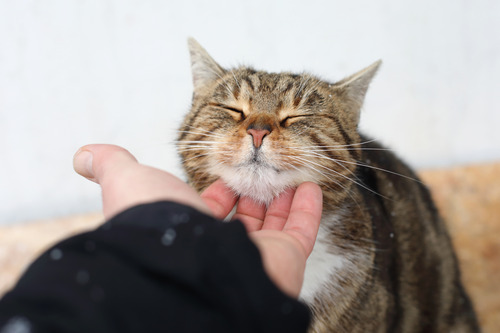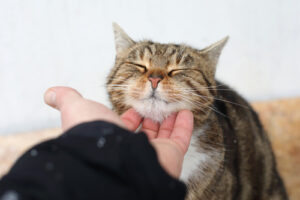Cats purr for a variety of reasons, and while most pet owners associate this sound with happiness, there’s much more behind this familiar vibration. When answering the question, “Why do cats purr?”, experts explain that it’s a complex form of communication and self-soothing behavior. Cats purr to express comfort, seek reassurance, ease stress, or even support healing. From kittens nursing to adult cats recovering from illness, purring serves several emotional and physiological purposes.
The Fascinating Science Behind a Cat’s Purr
To understand why cats purr, it helps to look at the mechanics behind the sound. Cats produce purring through rhythmic contractions of the muscles in their larynx (voice box), combined with the movement of the diaphragm. These contractions occur during both inhaling and exhaling, which creates the continuous humming sound pet owners recognize so easily.
Research shows that most domestic cats purr within a frequency range of 25 to 150 Hertz. Interestingly, this frequency is similar to the range known to promote healing in bone and tissue. This has led scientists to explore whether purring offers cats physical benefits beyond emotional expression.
The Role of Vibration in Healing
One theory about why cats purr suggests that the low-frequency vibrations can stimulate bone and muscle repair. Studies show that vibrations in this frequency range can promote bone density and tissue regeneration. It’s believed that cats may instinctively use purring as a way to help their bodies recover from injury or illness. This theory also explains why cats sometimes purr when they’re in pain or anxious, as it’s not always a sign of happiness. Rather, it may be a natural way to soothe themselves, much like a human’s deep breathing or meditation.
Communication Through Purring
When considering why cats purr, it’s important to remember that purring is also a form of communication. From the time they are born, kittens rely on purring as a way to interact with their mother and littermates.
Kittens and Maternal Bonding
Newborn kittens begin to purr at just a few days old. Because they are born blind and deaf, they use vibrations to communicate with their mother. A mother cat often purrs while nursing, signaling comfort and safety to her kittens. This early communication helps strengthen the bond between mother and offspring and encourages feeding.
Purring as a Social Signal
Adult cats also purr to communicate with humans and other animals. Many cats purr when they approach their owners, particularly during mealtime or when seeking affection. This behavior likely developed as a way to encourage nurturing and positive attention. Cats are remarkably attuned to their human companions and often learn to use purring in specific ways to get a response. For instance, “solicitation purrs” often have a slightly higher pitch, designed to grab attention, much like a baby’s cry. This subtle variation helps cats communicate their needs more effectively.
Emotional Benefits of Purring
Beyond physical and social functions, another reason why cats purr relates to emotional regulation. Purring can calm a cat’s nervous system and reduce stress. It’s also been shown to lower blood pressure and heart rate in both cats and humans.
Self-Soothing Behavior
Cats may purr during stressful or uncertain situations as a way to calm themselves. A visit to the veterinarian, a thunderstorm, or the introduction of a new pet might prompt a cat to purr. This self-soothing mechanism helps them cope with unfamiliar or frightening circumstances. In multi-cat households, purring can also help reduce tension. Cats may purr to signal peaceful intentions and prevent conflict, especially during social interactions.
The Human Connection
For humans, the sound of a cat’s purr has a naturally relaxing effect. Studies show that listening to a purring cat can reduce stress and anxiety, lower heart rate, and even promote emotional bonding. Pet owners who spend time with their cats often experience increased feelings of comfort and companionship. This mutual benefit strengthens the human-animal relationship and highlights the deep emotional role that cats play in people’s lives.
When Cats Purr in Unexpected Situations
Pet owners sometimes notice their cat purring in unusual circumstances such as during veterinary visits, after an injury, or even while giving birth. These moments can lead people to question why cats purr if they seem to be in distress.
Purring During Illness or Pain
Cats may purr when they are in pain or recovering from an injury. This doesn’t necessarily mean they are content; rather, it’s believed to be a natural response that promotes healing and comfort. Purring can help lower stress hormones, which supports recovery and overall well-being.
Purring in Senior Cats
Older cats often purr more frequently, especially if they experience arthritis or age-related discomfort. The vibrations may serve as a gentle form of physical therapy, helping them manage pain or stiffness. For senior cats, purring can also be a sign of seeking reassurance from their human companions.
How to Interpret Your Cat’s Purr
When trying to understand why cats purr, it’s essential to look at the context. Cats use purring in many different situations, so paying attention to their body language and environment can provide important clues.
- Relaxed and Content: If your cat is stretched out, kneading a blanket, or resting with half-closed eyes while purring, it’s likely a sign of contentment. These are moments of deep relaxation and trust.
- Nervous or Unwell: If your cat is hiding, refusing food, or showing other signs of distress while purring, it could indicate discomfort. While purring can be soothing, it’s important for pet owners to observe other behavioral cues to understand what their cat is feeling.
- Attention-Seeking: Many cats use purring to get attention. If your cat rubs against you and purrs while looking at you or near mealtime, they may simply be asking for food or affection. Cats are excellent at learning what behaviors get results from their owners.
Why Cats Purr Differently
Not every purr sounds the same, and that variation can reveal a lot about why cats purr in different circumstances.
The Solicitation Purr
The solicitation purr combines a traditional purr with a higher-pitched vocal element that resembles a cry. Cats often use this sound when they want something, typically food or attention. Studies suggest that humans find this sound particularly hard to ignore because it mimics the frequency of a baby’s cry.
The Contentment Purr
The contentment purr is softer, lower, and steady. It’s most often heard when cats feel safe and comfortable, such as while being petted or resting in their favorite spot.
The Stress Purr
This type of purr is often irregular and may occur during stressful events. Some cats purr loudly when they’re nervous or uncomfortable, which can confuse owners who interpret purring only as happiness.
The Remarkable Mystery of the Cat’s Purr
Even after decades of research, scientists continue to study why cats purr and what purposes it serves. While the behavior is universal among domestic cats, each cat’s reasons for purring are unique. Whether it’s a sign of affection, self-healing, or stress relief, purring remains one of the most fascinating aspects of feline behavior. Cats have evolved to use purring as a versatile tool: for communication, comfort, and health. Pet owners who pay attention to their cat’s purring patterns can better understand their needs and emotions.
If you ever have questions about your cat’s behavior or health, the team at Chimacum Valley Veterinary Hospital in Port Hadlock, WA, is here to help. Our compassionate team can assess your cat’s well-being and provide expert guidance tailored to their needs. Call (360) 385-4488 or book an appointment online today to schedule a visit with our experienced team.





